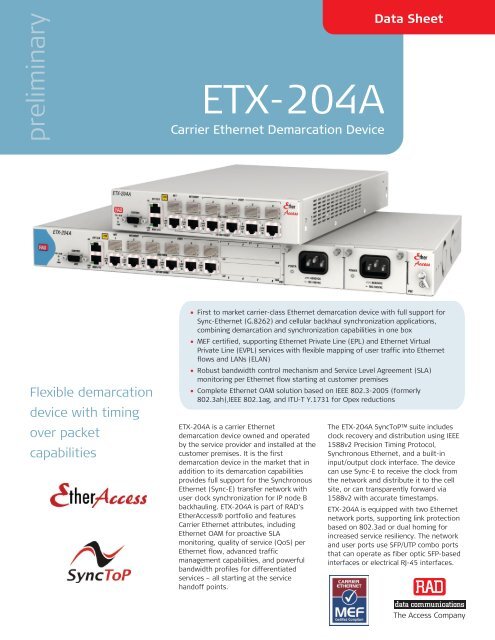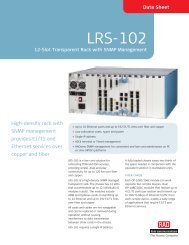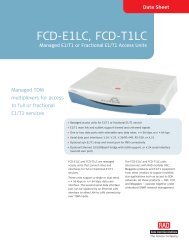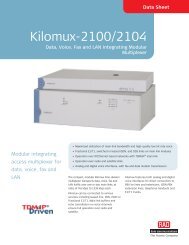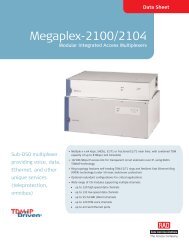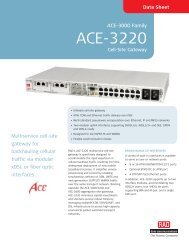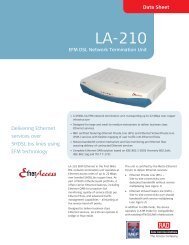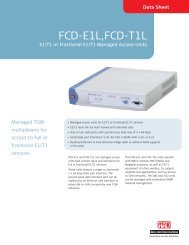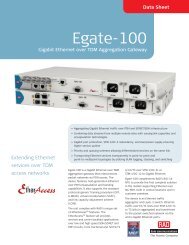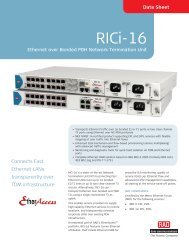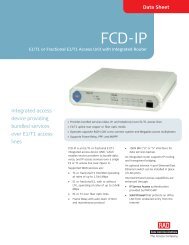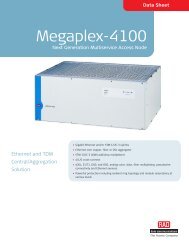ETX-204A - RAD TÜRKİYE Data Communications
ETX-204A - RAD TÜRKİYE Data Communications
ETX-204A - RAD TÜRKİYE Data Communications
Create successful ePaper yourself
Turn your PDF publications into a flip-book with our unique Google optimized e-Paper software.
preliminary<br />
<strong>ETX</strong>-<strong>204A</strong><br />
Carrier Ethernet Demarcation Device<br />
<strong>Data</strong> Sheet<br />
Flexible demarcation<br />
device with timing<br />
over packet<br />
capabilities<br />
• First to market carrier-class Ethernet demarcation device with full support for<br />
Sync-Ethernet (G.8262) and cellular backhaul synchronization applications,<br />
combining demarcation and synchronization capabilities in one box<br />
• MEF certified, supporting Ethernet Private Line (EPL) and Ethernet Virtual<br />
Private Line (EVPL) services with flexible mapping of user traffic into Ethernet<br />
flows and LANs (ELAN)<br />
• Robust bandwidth control mechanism and Service Level Agreement (SLA)<br />
monitoring per Ethernet flow starting at customer premises<br />
• Complete Ethernet OAM solution based on IEEE 802.3-2005 (formerly<br />
802.3ah),IEEE 802.1ag, and ITU-T Y.1731 for Opex reductions<br />
<strong>ETX</strong>-<strong>204A</strong> is a carrier Ethernet<br />
demarcation device owned and operated<br />
by the service provider and installed at the<br />
customer premises. It is the first<br />
demarcation device in the market that in<br />
addition to its demarcation capabilities<br />
provides full support for the Synchronous<br />
Ethernet (Sync-E) transfer network with<br />
user clock synchronization for IP node B<br />
backhauling. <strong>ETX</strong>-<strong>204A</strong> is part of <strong>RAD</strong>’s<br />
EtherAccess® portfolio and features<br />
Carrier Ethernet attributes, including<br />
Ethernet OAM for proactive SLA<br />
monitoring, quality of service (QoS) per<br />
Ethernet flow, advanced traffic<br />
management capabilities, and powerful<br />
bandwidth profiles for differentiated<br />
services – all starting at the service<br />
handoff points.<br />
The <strong>ETX</strong>-<strong>204A</strong> SyncToP suite includes<br />
clock recovery and distribution using IEEE<br />
1588v2 Precision Timing Protocol,<br />
Synchronous Ethernet, and a built-in<br />
input/output clock interface. The device<br />
can use Sync-E to receive the clock from<br />
the network and distribute it to the cell<br />
site, or can transparently forward via<br />
1588v2 with accurate timestamps.<br />
<strong>ETX</strong>-<strong>204A</strong> is equipped with two Ethernet<br />
network ports, supporting link protection<br />
based on 802.3ad or dual homing for<br />
increased service resiliency. The network<br />
and user ports use SFP/UTP combo ports<br />
that can operate as fiber optic SFP-based<br />
interfaces or electrical RJ-45 interfaces.<br />
The Access Company
<strong>ETX</strong>-<strong>204A</strong><br />
Carrier Ethernet Demarcation Device<br />
SFP/UTP COMBO PORTS<br />
The SFP/UTP combo Ethernet ports<br />
accommodate a wide range of Fast<br />
Ethernet and Gigabit Ethernet SFP<br />
transceivers, allowing service providers to<br />
seamlessly connect customers located at<br />
different distances from the device.<br />
FLEXIBLE TRAFFIC MAPPING<br />
Traffic is mapped to the Ethernet flows<br />
(EVCs) using very flexible classification<br />
criteria that can be combined, for<br />
example:<br />
• Port-based (All-to-one bundling)<br />
• VLAN + VLAN priority<br />
• VLAN + IP precedence<br />
• VLAN + DSCP<br />
• Ether Type<br />
• IP/MAC source/destination address<br />
• Untagged.<br />
More classification criteria and<br />
combinations can be found in the user<br />
manual.<br />
HIERARCHICAL SCHEDULING AND<br />
SHAPING PER FLOW<br />
Every flow has its own queues and<br />
scheduler. <strong>ETX</strong>-<strong>204A</strong> supports up to<br />
270 services, and a total of 30 queue<br />
blocks per network port. Each queue block<br />
is a group of eight queues per CoS. Each<br />
flow can be bound to each queue block.<br />
QOS<br />
Different service types require different<br />
levels of QoS to be provided end-to-end.<br />
QoS can be defined per subscriber as well<br />
as per service. QoS has three aspects: rate<br />
limitation, traffic shaping, and traffic<br />
prioritization.<br />
Traffic policing is applied per flow or group<br />
of flows, and operates according to the<br />
dual token bucket mechanism based on<br />
user-configurable CIR + CBS and EIR + EBS.<br />
Traffic can be limited to the line rate or<br />
the data rate.<br />
For prioritizing user traffic, <strong>ETX</strong>-<strong>204A</strong><br />
maps user traffic to up to eight separate<br />
queues per service. Each can be<br />
configured as strict priority queues or<br />
weighted fair queues (WFQ).<br />
The queues handle traffic with different<br />
service demands, such as real-time traffic,<br />
premium data, or best-effort data.<br />
The device uses the WRED policy to<br />
ensure that queues are not congested and<br />
high-priority traffic is not dropped.<br />
ETHERNET OAM<br />
<strong>ETX</strong>-<strong>204A</strong> provides these types of<br />
Ethernet OAM:<br />
• Single-segment (link) OAM according<br />
to IEEE 802.3-2005 (formerly 802.3ah)<br />
for remote management and fault<br />
indication, including remote loopback,<br />
dying gasp, and MIB parameter<br />
retrieval. Active and passive mode are<br />
supported.<br />
• End-to-end connectivity OAM based on<br />
IEEE 802.1ag that enables Ethernet<br />
service providers to monitor their<br />
services proactively and guarantee that<br />
customers receive the contracted SLA<br />
• End-to-end service and performance<br />
monitoring based on ITU-T Y.1731.<br />
Fault monitoring and end-to-end<br />
performance measurement include<br />
frame delay, frame delay variation,<br />
frame loss and availability.<br />
L2CP HANDLING<br />
<strong>ETX</strong> <strong>204A</strong> can be configured to pass<br />
through Layer-2 control frames (including<br />
other vendors’ L2CP frames) across the<br />
network, to peer supported protocols<br />
(802.3ah and LACP), or to discard the<br />
L2CP frames.<br />
NETWORK INTERFACE REDUNDANCY<br />
Two redundancy modes can be applied:<br />
• Link aggregation (LAG) based on<br />
802.3ad<br />
• Dual homing (1:1), allowing <strong>ETX</strong>-<strong>204A</strong><br />
to be connected to two different<br />
upstream devices.<br />
TYPICAL APPLICATIONS<br />
<strong>ETX</strong>-<strong>204A</strong> is used in the following<br />
MEF-defined applications:<br />
• IP Node B backhauling – <strong>ETX</strong>-<strong>204A</strong> acts<br />
as a transport demarcation device,<br />
connecting the base station to the<br />
packet network. This provides a clear<br />
demarcation between the service<br />
domain and the transport domain with<br />
proactive service monitoring and easy<br />
fault localization throughout the entire<br />
network (see Figure 1).<br />
• Ethernet Private Line (EPL) –<br />
Site-to-site connectivity over<br />
dedicated bandwidth without service<br />
multiplexing (see Figure 2)<br />
• Ethernet Virtual Private Line (EVPL) –<br />
Site-to-site connectivity over shared<br />
bandwidth with service multiplexing<br />
(see Figure 3)<br />
• Ethernet LAN (ELAN) – Site-to-site<br />
connectivity over dedicated bandwidth<br />
with or without service multiplexing.<br />
JUMBO FRAMES AND EGRESS MTU<br />
The unit supports large frames of up to<br />
12 Kbytes.<br />
ENVIRONMENT<br />
<strong>ETX</strong>-<strong>204A</strong>/H is a temperature-hardened<br />
version with matching SFPs intended for<br />
industrial installations, available in both<br />
19” and 8.5” enclosures.<br />
Figure 1. IP Node B Backhauling
LAYER-2/ LAYER-3 LOOPBACK WITH<br />
MAC AND IP ADDRESS SWAPPING<br />
As services and networks become more<br />
complex, tracking service and network<br />
faults is very important for conforming to<br />
the SLA. Therefore it is vital that the<br />
service provider can perform network<br />
loopbacks to easily track failures. Layer-2<br />
and/or layer-3 network integrity can be<br />
tested by a non-disruptive loopback<br />
performed per flow, with swapping of<br />
MAC address and optionally IP address.<br />
When the loopback is activated, <strong>ETX</strong>-<strong>204A</strong><br />
exchanges the source and destination<br />
MAC/IP addresses of the incoming<br />
packets. This loopback passes through<br />
Ethernet bridges (MAC address) and<br />
routers (IP address).<br />
MANAGED QOS IN NEXT-GENERATION<br />
<strong>RAD</strong>IO ACCESS NETWORKS<br />
<strong>ETX</strong>-<strong>204A</strong> delivers managed quality of<br />
service in next-generation radio access<br />
networks (RANs), allowing mobile<br />
operators to enhance their 3.5G/4G<br />
service performance by combining<br />
Ethernet aggregation with OAM and SLA<br />
enforcement capabilities – starting at the<br />
eNodeB, HSDPA base station, or WiMAX<br />
cell site.<br />
CELLULAR BACKHAUL<br />
SYNCHRONIZATION<br />
<strong>ETX</strong>-<strong>204A</strong> provides powerful<br />
synchronization capabilities, ensuring<br />
highly accurate, seamless delivery of 2G,<br />
3G, and 4G traffic over packet backhaul.<br />
This enables mobile operators and<br />
transport providers to eliminate the risk of<br />
service disruptions, impaired cell handoffs,<br />
and excessive dropped calls, thereby<br />
supporting reliable transmission of<br />
real-time traffic over PSNs.<br />
The device also ensures QoS priorities for<br />
clock traffic and supports “SDH/SONET or<br />
Better” performance requirements for<br />
voice and video traffic, such as up to<br />
16 ppb (parts per billion) frequency<br />
accuracy.<br />
COLOR-SENSITIVE RE-MARKING BASED<br />
ON CIR/EIR<br />
The device features unique color-sensitive<br />
p-bit re-marking capabilities that assign<br />
color-specific p-bit values to Ethernet<br />
frames at network ingress to ensure<br />
metering continuity across the Metro<br />
Ethernet network.<br />
FAULT PROPAGATION<br />
The unit provides a user-configurable fault<br />
propagation mechanism in the<br />
network-to-user or user-to-network<br />
direction. When a link failure is detected<br />
or OAM failure received, <strong>ETX</strong>-<strong>204A</strong> can<br />
shut down the affected port or forward<br />
the OAM failure message. The fault<br />
propagation mechanism enables routers<br />
and switches connected to both ends of<br />
the link to reroute the traffic to the<br />
redundancy path.<br />
ALARM SYNCHRONIZATION<br />
Traps are sent with sequence IDs to<br />
network manager groups, to enable the<br />
managers to detect when traps are lost<br />
and request the traps be sent again.<br />
DYING GASP<br />
<strong>ETX</strong>-<strong>204A</strong> reports power failures to<br />
defined network management stations by<br />
sending a trap, thus enabling the unit to<br />
properly disconnect from the network<br />
with notification of the reason for the<br />
service problem.<br />
COMMAND LINE INTERFACE<br />
<strong>Data</strong>bases and scripts of commonly used<br />
commands can be easily created and<br />
applied to multiple units using command<br />
line interface.<br />
MANAGEMENT<br />
The unit can be managed using the<br />
following ports and applications:<br />
• Local management via an ASCII<br />
terminal connected to the RS-232 port<br />
• Remote inband management via user<br />
or network ports routed via separate<br />
VLANs, Telnet, or <strong>RAD</strong>view, <strong>RAD</strong>’s<br />
SNMP-based management system<br />
• Out-of-band management via a<br />
dedicated management port<br />
• SFTP – Secure File Transfer Protocol.<br />
SECURITY<br />
The following security protocols are<br />
provided by <strong>ETX</strong>-<strong>204A</strong> to ensure client<br />
server communication privacy and correct<br />
user authentication:<br />
• SNMPv3<br />
• <strong>RAD</strong>IUS (client authentication only)<br />
• SSH for Secure Shell communication<br />
session.<br />
DHCP<br />
IP address, IP mask, and default gateway<br />
can be automatically obtained using DHCP.<br />
Specifications<br />
NETWORK INTERFACE<br />
Number of Ports<br />
Up to 2 (redundancy)<br />
Type<br />
SFP/UTP combo port:<br />
Fiber optic:<br />
Fast Ethernet (100BaseFx, 100BaseLX10,<br />
100BaseBx10, 100BaseT), SFP-based<br />
Gigabit Ethernet (1000BaseSx,<br />
1000BaseLX10, 1000BaseBx10,<br />
1000BaseT), SFP-based<br />
Copper: 10/100/1000BaseT (built-in)<br />
Connector<br />
SFP slot or RJ-45<br />
SFP Transceivers<br />
For full details, see the SFP Transceivers<br />
data sheet at www.rad.com<br />
Note: It is strongly recommended to order this<br />
device with original <strong>RAD</strong> SFPs installed. This will<br />
ensure that prior to shipping, <strong>RAD</strong> has performed<br />
comprehensive functional quality tests on the<br />
entire assembled unit, including the SFP devices.<br />
<strong>RAD</strong> cannot guarantee full compliance to product<br />
specifications for units using non-<strong>RAD</strong> SFPs.<br />
USER INTERFACE<br />
Number of Ports<br />
Up to 5<br />
Type<br />
SFP/UTP combo port<br />
Connector<br />
SFP slotor RJ-45<br />
SFP Transceivers<br />
For full details, see the SFP Transceivers<br />
data sheet at www.rad.com<br />
EXTERNAL CLOCK PORT<br />
External input or output via optional<br />
dedicated E1 or 2.048 MHz port (G.703),<br />
RJ-45 connector
<strong>Data</strong> Sheet<br />
MANAGEMENT PORTS<br />
Out-of-Band Ethernet Management<br />
Port<br />
Type: 10/100BaseT<br />
Connector: RJ-45<br />
Control Port<br />
Interface: V.24/RS-232 DCE<br />
Connector: 9-pin D-type, female<br />
Format: Asynchronous<br />
<strong>Data</strong> rate: 9.6, 19.2, or 115.2 kbps<br />
GENERAL<br />
Max. Frame Size<br />
12,288 bytes<br />
Certifications<br />
MEF 9, MEF 14: EPL and EVPL<br />
Compliance<br />
MEF 6 (E-Line – EPL and EVPL), MEF 10<br />
IEEE 802.3, 802.3u, 802.1d, 802.1q,<br />
802.1p, 802.3ad, 802.3ah, 802.1ag,<br />
ITU-T Y.1731<br />
Management<br />
Out-of-band via:<br />
Control port<br />
Ethernet management port:<br />
Inband: via Ethernet network/user port<br />
Indicators<br />
PWR (green):<br />
On –<strong>ETX</strong>-<strong>204A</strong> is powered up<br />
TST/ALM (red):<br />
On – One of the Ethernet links is down<br />
Blinking – Diagnostic loopback is active<br />
LINK/ACT ETH (green):<br />
On – Ethernet link OK<br />
Blinking – <strong>Data</strong> is being transmitted<br />
and received on the Ethernet link<br />
LINK/ACT CLK (green):<br />
On – Station clock port connected<br />
Power<br />
AC power supply:<br />
100–240 VAC, 50/60 Hz<br />
Wide-range DC power supply:<br />
24/48V (20–72VDC)<br />
Power Consumption<br />
18.5W max<br />
Physical<br />
Unit with single power supply:<br />
Height: 43.7 mm (1.7 in)<br />
Width: 215 mm (8.4 in)<br />
Depth: 300 mm (11.8 in)<br />
Weight: 2.4 kg (5.2 lb)<br />
Unit with dual power supply:<br />
Height: 43.7 mm (1.7 in)<br />
Width: 440 mm (17.4 in)<br />
Depth: 240 mm (9.5 in)<br />
Weight: 3.1 kg (6.8 lb)<br />
Environment<br />
Temperature:<br />
<strong>ETX</strong>-<strong>204A</strong>: 0–50°C (32–122°F)<br />
<strong>ETX</strong>-<strong>204A</strong>/H: -40–65°C (-40–149°F)<br />
Humidity: Up to 90%, non-condensing<br />
Figure 2. Ethernet Virtual Line<br />
Figure 3. Ethernet Virtual Private Line
<strong>ETX</strong>-<strong>204A</strong><br />
Carrier Ethernet Demarcation Device<br />
Table 1. <strong>ETX</strong> Family Comparison Table<br />
Feature<br />
<strong>ETX</strong>-102<br />
(Ver. 3.6<br />
<strong>ETX</strong>-201<br />
(Ver. 3.6)<br />
<strong>ETX</strong>-202<br />
(Ver. 3.6)<br />
<strong>ETX</strong>-201A<br />
(Ver. 1.67)<br />
<strong>ETX</strong>-<strong>204A</strong><br />
(Ver. 2.2B)<br />
Network<br />
interface<br />
Network/<br />
User<br />
interface<br />
User<br />
interface<br />
Up to 2 × Fast<br />
Ethernet<br />
Not applicable<br />
Up to 5 × Fast<br />
Ethernet<br />
Up to 2 × Gigabit or<br />
Fast Ethernet<br />
(auto-detect)<br />
Gigabit or<br />
Fast Ethernet<br />
(auto-detect)<br />
Up to 5 × Fast<br />
Ethernet<br />
2 × Gigabit or<br />
Fast Ethernet<br />
(auto-detect)<br />
Gigabit or<br />
Fast Ethernet<br />
(auto-detect)<br />
Up to 4 × Gigabit<br />
Ethernet<br />
Up to 2 × Gigabit or<br />
Fast Ethernet<br />
Gigabit or<br />
Fast Ethernet<br />
Optional 1 Gigabit<br />
and up to 4 × Fast<br />
Ethernet<br />
Service type EPL (port-based) EPL (port-based) EPL (port-based) EPL and EVPL<br />
(flow-based)<br />
Forwarding<br />
mode<br />
Max. frame<br />
size<br />
QoS<br />
Bandwidth<br />
profile<br />
Management<br />
interface<br />
VLAN-aware/unaware<br />
bridging,<br />
8K MAC addresses<br />
VLAN-aware/unaware<br />
bridging,<br />
8K MAC addresses<br />
VLAN-aware/unaware<br />
bridging,<br />
8K MAC addresses<br />
Flow-based<br />
forwarding<br />
Up to 2 × Gigabit or Fast Ethernet<br />
SFP/UTP combo ports<br />
Gigabit or Fast Ethernet<br />
SFP/UTP combo ports<br />
Up to 5 × Gigabit Ethernet<br />
SFP/UTP combo ports<br />
EPL and EVPL (flow-based)<br />
Flow-based forwarding<br />
1,632 bytes 1,632 bytes 4,096 bytes 12,288 bytes 12,288 bytes<br />
Rate limitation<br />
Traffic classification<br />
(802.1p bits, ToS,<br />
DSCP, port-based)<br />
Rate limitation<br />
Traffic classification<br />
(802.1p bits, ToS,<br />
DSCP, port-based)<br />
Rate limitation<br />
Traffic classification<br />
(802.1p bits, ToS,<br />
DSCP, port-based)<br />
Rate limitation per<br />
flow<br />
Traffic classification<br />
(Port-based, VLAN,<br />
802.1p bits, ToS,<br />
DSCP)<br />
Shaping<br />
Rate limitation per flow<br />
Traffic classification<br />
(Port-based, VLAN, 802.1p bits,<br />
ToS, DSCP)<br />
Shaping<br />
CIR/CBS per port CIR/CBS per port CIR/CBS per port CIR/CBS, EIR/EBS per CIR/CBS, EIR/EBS per EVC.COS<br />
EVC.COS<br />
Menu-driven Menu-driven Menu-driven Command line Command line
<strong>ETX</strong>-<strong>204A</strong><br />
Carrier Ethernet Demarcation Device<br />
<strong>Data</strong> Sheet<br />
Ordering<br />
<strong>ETX</strong>-<strong>204A</strong>//!/BT/B/_<br />
Legend<br />
Temperature range (Default=Regular<br />
enclosure):<br />
H Temperature-hardened enclosure<br />
Note: The <strong>ETX</strong>-<strong>204A</strong>/H version requires<br />
industrially-hardened SFP transceivers.<br />
! Power supply (Default=Single AC<br />
power supply in 1U 8.5” enclosure):<br />
AC Single AC power supply<br />
DC Single DC power supply<br />
ACR Dual AC power supply in 1U 19”<br />
enclosure<br />
DCR Dual DC power supply in<br />
1U 19” enclosure<br />
BT Enclosure (Default=8.5” metal<br />
enclosure):<br />
19 19” metal enclosure<br />
Note: Units with dual power supplies require the<br />
19” enclosure.<br />
B Number of user ports<br />
(Default=2 user ports):<br />
4 4 user ports<br />
_<br />
Timing<br />
(Default=No hardware support for<br />
synchronization over packet):<br />
SYE SYNC-Ethernet full support<br />
SUPPLIED ACCESSORIES<br />
AC power cord<br />
DC connection kit (if DC power supply is<br />
ordered)<br />
OPTIONAL ACCESSORIES<br />
<strong>ETX</strong>-<strong>204A</strong>_PS/!<br />
! Power supply<br />
AC Single AC power supply<br />
DC Single DC power supply<br />
RM-34<br />
Hardware kit for mounting one <strong>ETX</strong>-<strong>204A</strong><br />
unit with 19” enclosure in a 19" rack<br />
RM-35/+<br />
Hardware kit for mounting one or two<br />
<strong>ETX</strong>-<strong>204A</strong> units with 8.5” enclosure in a<br />
19" rack<br />
+ Rack mount kit (Default=Both kits):<br />
P1 Kit for mounting one unit<br />
P2 Kit for mounting two units<br />
WM-34<br />
Hardware kit for mounting one <strong>ETX</strong>-<strong>204A</strong><br />
unit with 19” enclosure on a wall<br />
WM-35<br />
Hardware kit for mounting one <strong>ETX</strong>-<strong>204A</strong><br />
unit with 8.5” enclosure on a wall<br />
CBL-DB9F-DB9M-STR<br />
Control port cable<br />
254-110-10/09 Specifications are subject to change without prior notice. © 1988–2009 <strong>RAD</strong> <strong>Data</strong> <strong>Communications</strong> Ltd. The <strong>RAD</strong> name, logo, logotype, and the terms EtherAccess, TDMoIP and TDMoIP Driven, and the<br />
product names Optimux and IPmux, are registered trademarks of <strong>RAD</strong> <strong>Data</strong> <strong>Communications</strong> Ltd. All other trademarks are the property of their respective holders.<br />
International Headquarters<br />
24 Raoul Wallenberg Street<br />
Tel Aviv 69719, Israel<br />
Tel. 972-3-6458181<br />
Fax 972-3-6498250, 6474436<br />
E-mail market@rad.com<br />
North America Headquarters<br />
900 Corporate Drive<br />
Mahwah, NJ 07430, USA<br />
Tel. 201-5291100<br />
Toll free 1-800-4447234<br />
Fax 201-5295777<br />
E-mail market@radusa.com<br />
www.rad.com Order this publication by Catalog No. 000000<br />
The Access Company


